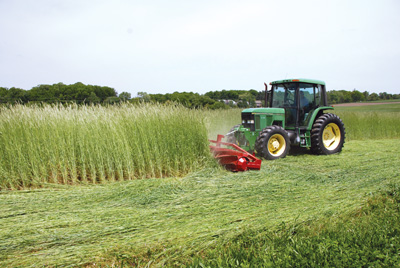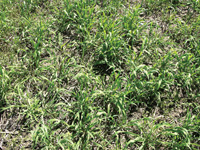
Features
Agronomy
Other Crops
Rye for weed control, and more
In a dark world, a deadly chemical oozes towards an unsuspecting victim. That may be a little melodramatic, but some plants, including rye, do indeed release chemicals into the soil that could suppress other plants.
August 13, 2010 By Carolyn King
In a dark world, a deadly chemical oozes towards an unsuspecting victim. That may be a little melodramatic, but some plants, including rye, do indeed release chemicals into the soil that could suppress other plants. Researchers at the United States Department of Agriculture (USDA) are exploring rye’s ability to chemically suppress weeds, called allelopathy, with the goal of making rye an even more effective cover crop.
 |
|
| Some growers use special equipment to roll rye cover crops, creating a residue mat to suppress weeds. Photo courtesy of Steven Mirsky, USDA-ARS. |
One of rye’s strengths as a cover crop is weed suppression. Along with its allelopathic effect, rye’s vigorous growth out-competes weeds while the crop grows and results in plenty of crop residue for a physical barrier against weed growth after the crop dies. The USDA’s Drs. John Teasdale and Cliff Rice hope to understand the chemistry behind rye’s allelopathic effect and the importance of allelopathy to rye’s overall effect on weeds.
Their study involves killing a rye cover crop in the spring, then either leaving the crop residues on the soil surface or tilling the residues into the soil. They take weekly soil samples from both treatments, extract the allelopathic compounds from the samples, and test the effects of the compounds on other plants. “We want to determine if the compounds are present in the soil at sufficient concentrations and for sufficient time to be responsible for rye’s allelopathic effects,” says Teasdale, a research leader with the USDA Agricultural Research Service (ARS) in Beltsville, Maryland.
Just like soil-active herbicides, allelopathic compounds have to remain active in the soil long enough to affect weeds. Teasdale explains, “There are many things that can happen to a chemical when it’s released into the soil. It can go through various types of degradation: degradation by micro-organisms, chemical degradation, photodegradation. It can be metabolized and changed into other forms. And the rate at which these changes happen is of critical importance.”
To add to this biochemical complexity, rye releases various types of compounds that might have an allelopathic effect. Rice, a chemist with the Agricultural Research Service, initially focused on a group of chemicals called benzoxazinoids. “Over the last 20 years, the benzoxazinoid group have been claimed by many researchers to be responsible for the allelopathic effect of rye,” says Teasdale.
Rice has looked at the many different forms of this group of chemicals and has found that the forms in rye roots are different from those in rye top-growth. However, he has also found that benzoxazinoids probably are not the cause of rye’s allelopathic effect. Teasdale adds, “Basically the results of our research to date indicate that the benzoxazinoids are not in the soil long enough and are not at a high enough concentration in the soil to affect the weeds. When they enter the soil, they seem to be degraded or adsorbed on to the soil quite quickly. Overall, rye residue only seems to release these compounds for a period of a week or two.”
The study’s next step is to test other allelopathic compounds released by rye, including a group of compounds called phenolics, to look for ones that remain active in the soil for a longer period.
Teasdale notes, “A whole other possibility is that the rye plants simply release enough solutes (dissolved substances) into the soil that there is a pulse of salts, which causes a temporary osmotic effect. So there isn’t any particular compound; it is the net total amount of compounds released, and they cause a change in the electrical conductivity in the salt concentrations in the soil that may affect weeds.”
The study’s results could help point the way to enhancing the weed-control effects of rye. Teasdale gives an example: “Organic agriculture, until recently, has been really dependent on cultivation to control weeds. Cultivation is destructive of soil organic matter, so organic farmers are interested in reducing the amount of tillage. One approach is to use a cover crop like rye. New equipment has been developed to roll a cover crop, so you can roll the rye cover crop, which kills it and leaves the residue flat on the soil surface, and that will physically suppress weeds. From the standpoint of a scientist, it is of interest to know if this weed suppression is because the cover crop just smothers any weeds that try to grow through that physical mat of residue or if the residue also releases chemicals that inhibit growth. If it is just physical suppression, then you’d be looking for rye cultivars that produce high amounts of residue. If there is a chemical component to it, then you might develop a breeding program that would try to enhance the production of the particular compounds that are involved.”
Does a rye cover crop fit into every crop rotation?
“A cover crop has to be part of the cropping system, so cover crop selection somewhat depends on what the goals are for planting it. Once you know that, then you can zero in on options for which cover crop to use,” says Adam Hayes, soil management specialist for field crops with the Ontario Ministry of Agriculture, Food and Rural Affairs.
 |
|
| Rye has many strengths as a cover crop, including the ability to release natural chemicals to control weeds. Photo courtesy of OMAFRA. |
Goals for a cover crop might be to reduce soil erosion; improve soil structure and health; inhibit weeds; diseases or insect pests; and/or manage nutrients. Each cover crop type has its own particular strengths and weaknesses in performing these functions.
When choosing a cover crop, a key aspect to consider is how the cover crop type fits with the previous and following crops in a grower’s rotation. Hayes notes, “People should consider what crop is following it and whether there would be disease or insect pest implications from the cover crop. And they need to be sure that any herbicides that were used ahead of the cover crop aren’t going to impact the cover crop.”
Hayes says that some of the more common options for cover crops in Ontario are cereals such as oats, rye or winter wheat, grasses such as sorghum sudan, pearl millet, or ryegrass; legumes such as hairy vetch, red clover, sweet clover or field pea; and other broadleaves such as buckwheat or oilseed radish. He adds, “There is also some research being done to look at mixtures, like using a broadleaf, a legume, and a grass or a cereal crop together as a mixture. That way, if one does a little better than another in the growing conditions that you have, you would still get pretty good growth overall.”
A rye cover crop has quite a few strengths. “Rye is relatively inexpensive. It will germinate at fairly low temperatures and grow at lower temperatures than some other crops. It provides good ground cover protection; it survives the winter and it is there to help protect the soil from wind or water erosion. Where people have killed it and planted a crop right into it, it can provide a good mulch, especially on sandy loam or sandy soils, to prevent erosion and help conserve soil moisture,” explains Hayes. “Rye has an extensive fibrous root system, which is really good for helping to build soil structure. You can get a lot of growth from rye and put a reasonable amount of organic matter back into the soil. Research shows it can help to suppress weeds. And it has the potential to be grazed by livestock, if that is part of the equation.”
Rye is also able to temporarily hold nitrogen, which is important in some production systems. Hayes provides an example: “If someone is applying manure after a winter wheat crop and working it into the soil, some of the nitrogen in that manure has the potential to be lost if it’s in the soil from that time until the next spring, when a crop might start to use it. So depending on the cover crop that is grown, it can help to take up some of that nitrogen and essentially tie it up over the winter and then release it in the following year for a crop that would require nitrogen.”
However, rye does not fit in every production system. For instance, if a rye cover crop is grown between two cereal crops, it might harbour disease or insect pests that could affect the next crop. Another issue can be rye’s vigorous top-growth. Hayes says, “If there’s a lot of rye growth and depending on how it is managed in the following spring, there could be a lot of residue on the surface, which in some years could cause slug problems.”
For growers who decide that a rye cover crop fits with their cropping system, Hayes has a few recommendations. “The seeding rates for rye are typically 90 to 110 lbs/ac, although some growers will seed it as low as about 60 lbs/ac. It can be broadcast on the soil and worked in. Probably the best method for establishment would be using a drill, and obviously if there’s a lot of residue using a no-till drill. Typically, rye is planted in August to October, but the timing often depends on when you have the opportunity to plant it.”
He also reminds growers who are new to using rye as a cover crop to keep an eye on it in the spring to make sure the rye does not get too high. “If you have a warm, wet spring, rye can grow quite rapidly. It can go from six inches to a foot in a pretty short time under the right conditions.”